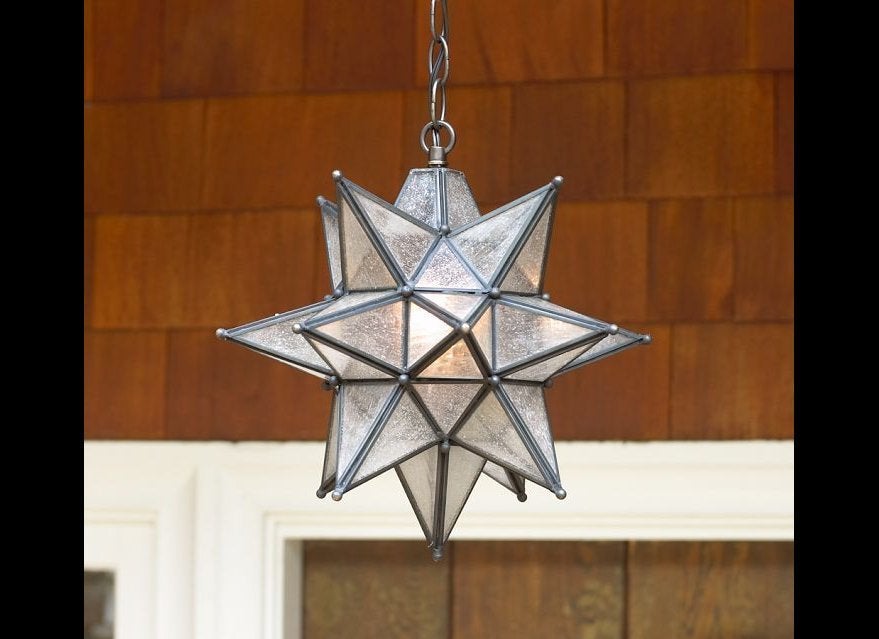When it comes to picking out lighting fixtures for your home, consider the pendant light, which hangs on a cord or a chain from the ceiling. The pendant has become a popular choice among homeowners since it's not as bulky and expensive as chandeliers and it makes for great task lighting in workspaces like the kitchen. Moreover pendant lights make for attractive focal points in any space while doubling as a lighting source. Also, a pendant can be a space-saving alternative to a floor lamp or table lamp because they can provide ambiant lighting over a greater surface area.
The style and shape of the pendant light you choose depends on your home and the room where the fixture will be used. However, here are some very general things you should keep in mind when looking for a pendant light.
Consider material and finishes. The most common materials used for pendant lights include glass, metal, cloth and plastic. Clear glass will naturally diffuse light more effectively in all directions, which makes them great for areas like the kitchen and bathroom. Similarly, metals with shiny finishes like polished chrome and brushed nickel can also help reflect light. For drum-shaped pendant lights made from cloth, dust can collect easily so they're best used in spaces like the living room where cleaning simply requires quick dusting. And, while plastic is the most cost-effective option, they're prone to discoloration over time, so using them in corners and nooks that are not as highly trafficked can help make them longer-lasting.
Decide on big or small pendants. A single big pendant light is great for an entryway where one source of lighting is often enough. It can also serve as a focal point in the space. Likewise, big pendant lights work well above round dining tables for the same reason. On the other hand, small pendants, such as mini globes, are great alternatives to installing track lighting. They provide bright but less intense lighting all around, so they work well as task lighting in the kitchen -- hang them in multiples (for sufficient lighting) and above eye level (to prevent possible glare).
Ambient versus task lighting. Depending on the shape or the type of shade used on a pendant, light is either directed up or down. Pendants that are inverted (they look like upside down table lamps) streams light up to the ceiling, providing ambient or mood lighting in a space. On the contrary, pendants with open bottoms often focus light downward, making them perfect as task lighting above a workspace like the kitchen island.
LED versus traditional bulbs. Some pendant lights are available with only LED bulbs, which are great for task lighting but more expensive than traditional bulbs. The style of the pendant will ultimately determine the type of bulb required. However, keep in mind that LED bulbs, while pricey, tend to last longer than standard bulbs that need to be replaced more frequently.
Decide on plug-in or hardwiring. While plug-in pendant lights are much less labor intensive, they do require longer cords and, sometimes, maybe even an extension cord in order for the light to be plugged in. Hardwiring does offer a clean and more polished look since there will be no dangling cords and visible plugs, but installation is more labor intensive. However, if you're picking out a permanent fixture that will be the primary light source in a space (over kitchen counters or dining table), hardwiring is a better long-term investment.
Keep height in mind. How the pendant light will be used will also determine how high it should be hung. For an entryway, seven feet above the floor is recommended. If you're using a pendant in a dining area, it's generally best to suspend the light at least 30" above the table. Similarly, pendants used for a kitchen island area should be 30"-40" above the counter. However, keep in mind the height of the tallest person in your home; there should be at least 20-25" between the top of the person's head and the bottom of a pendant fixture -- this keeps them from getting the impulse to duck under the light.
Consider cord length. Generally go with a cord that's at least 4'-6' long for a hardwire pendant and one that's at least 9' long for plug-ins. These should offer enough leeway for adjustments according to how high or low you would like to hang the pendant light above a surface. For spaces with high ceilings, find out how tall the ceilings are to determine how long of a cord you will need. Many places sell cords that are as long as 15' or more.
Check out the slideshow below to see some of our favorite picks for pendant lights in the marketplace now. And, let us know in comments below what you look for when shopping for pendant lights.
